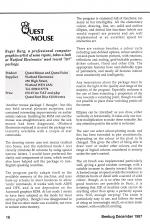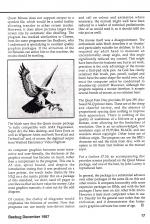
Beebug
 1st December 1987
1st December 1987
Categories: Review: Peripheral
Author: Roger Burg
Publisher: Watford Electronics
Machine: BBC B/B+/Master 128
Published in Beebug Volume 6 Number 7
Roger Burg, a professional computer graphics artist of some repute, takes a look at Watford Electronics' most recent "Art" package.
Quest Mouse (Watford Electronics)
"Another mouse package!" I thought - but this one held several pleasant surprises, and contained interesting improvements on earlier artistic rodents. Installing the ROM unit and the mouse was straightforward, and once the sick mouse had been diagnosed, (Watford Electronics replaced it at once) the package was instantly available with a couple of star commands.
The drawing screen uses text menus crushed into boxes, and the redefined mode 1 text cleverly simulates 80 columns by using special narrow letters. I would have preferred the clarity and compactness of icons, which would also have helped sell the package to non-English speaking countries.
The program partly adapts itself to the available memory of the machine, and uses back-up screens in most instances to allow 'undo' commands. It works with both ADFS and DFS, and is not dependent on the Acornsoft graphics ROM. At last mode 1 seems to have been adopted as the mode for most serious graphics, though I was disappointed to find that no other mode was available, not even to reclaim extra memory.
The program is crammed full of functions; too many to list intelligibly. All the elementary colour, drawing, line, arc, solid and outline ellipses, and dotted line functions (which one would expect) are present and are well implemented at an excellent speed for interactive art.
There are various brushes, a colour cycle including user-defined options, colour sensitive cut-and-paste between pictures, with rotations, reflections and scaling, grid-lockable patterns, dither colours, flood and other fills. The appropriate features have user-definable types or parameters, and nearly all features interact most consistently and intelligently.
Any reservations about the package must be read in the light of the quality and range of the majority of the program. Especially welcome is the use of lines extending a proportion of the way towards a vanishing point, though it is still not possible to place these vanishing points off the screen.
Ellipses can be 'stretched' as you draw, either vertically or horizontally. It takes only one two-byte multiplication to make these rotatable. But any attention paid to the artist is welcome!
The user can select colour-plotting mode, and this has been extended to plot conditionally, depending on the colour of the pixel to be changed. This gives the effect of being able to draw 'over' or 'under' other colours, and the range of logical colours considered is entirely under the user's control.
The air brush was implemented particularly well, giving a good random coverage, with a suitable increase in density toward the centre. A limited range of speed avoids the tendency to obliterate hours of detail with a second of solid colour, though, as is so often the case when good routines are possible in Basic, it is irritating that 32K of machine code cannot do anything other than spray a perfectly square area. Still, enough carping! The zoom is particularly easy to use, and follows the trend of using an increasingly small, on-screen zoom window, with excellent scrolling.
Quest Mouse does not support output to a spooled file, which would be a useful facility allowing transfer to other screen modes. However, it does allow pictures larger than screen size by automatic disc shuffling. The program has marked similarities to Cheese, from the same programmer Ian Bradbury, who I understand is specialising in excellent quality graphics packages. If the attraction of the Archimedes can entice him to that machine, the results should be startling.
The blurb says that the Quest mouse package is "fully compatible with AMX Pagemaker, Super Art, the Max desktop, and Extra Extra as well as Wigmore Artist and both NovaCad and TechnoCad" and, of course, the digitized output from Watford Electronics' Video Digitizer.
As computer graphics becomes more interactive and user-friendly, the thickness of the graphics manual has become an insult, rather than a complement to the program. This one is A5 size, spiral bound, and despite the introduction stating that it was produced on a laser printer, the result looks distinctly like NLQ on a dot matrix printer. But on a package of this standard, we don't need 60 pages to convince us that we have value for money. Like most graphics manuals, it cries out for the odd diagram.
Of course, the clarity of diagrams would emphasise the thinness of content. Now that programs can use mostly icon-driven menus and call on colour and animation where necessary, the manual might well have been reduced to a leaflet of technical preliminaries (few of us would read it, so it should fulfil the role just as well).
The mouse itself was a disappointment. The enthusiastic sales blurb describes it as 'chunky' and particularly suitable for children. In fact, it required my adult hand to maintain an uncomfortably steep angle, and this angle significantly reduced my control. This might have been fine for business use, but in art work, precision is the only advantage of the mouse over a Graf-pad style pen. As God has clearly ordained that brush, pen, pencil, scalpel and burin have the same shape the world over, why must the computer artist be condemned to shoulder-tip control? However, although the program requires a mouse interface, it accepts several breeds of mouse, so no criticism here.
The Quest Font Disc provides 29 (yes 29!) disc-based NLQ printer fonts. These are of the cheap and cheerful variety, and the absence of proportional spacing does nothing to improve their appearance. There is nothing of the quality or usefulness of a Univers or a good Roman, even allowing for the limitations of resolution. One is an un-acknowledged, low resolution copy of FUTURA BLACK, and one wonders about copyright. Other fonts are of dubious origin. The program can use the BBC's character set and the fonts from disc, with an option to tilt them (not italicise as the manual says).
For a further £7.50, an accompanying disc provides screens produced on the Quest Mouse package, and one of the best, by John Lavery is reproduced here.
In general, the package is a substantial advance over other packages of the same ilk on this and other micros. It compares favourably with some expensive packages on IBMs, and with the best packages I have seen on any other 8-bit micro. However it feels most competent when in use. It's 'friendly' for the general user rather than the enthusiast, and it demonstrates that home-user's graphics software has come of age.
This article was converted to a web page from the following pages of Beebug Volume 6 Number 7.



